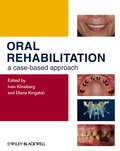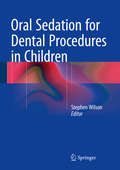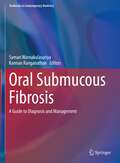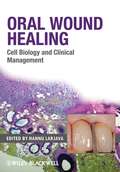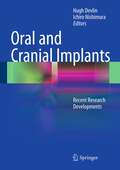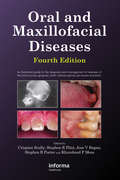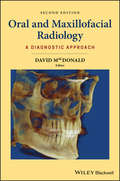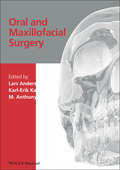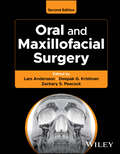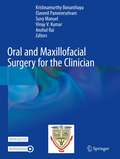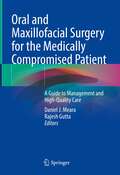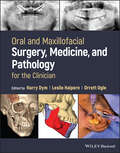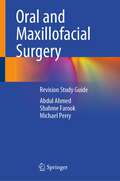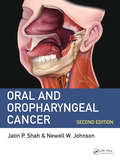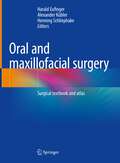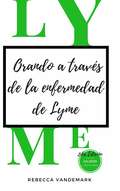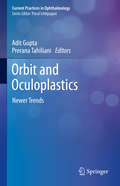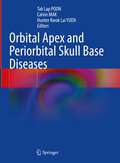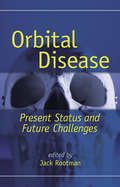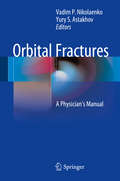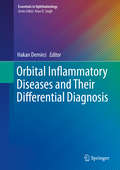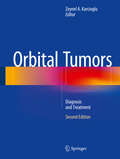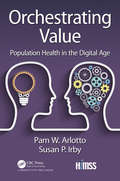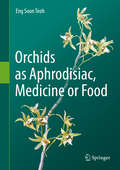- Table View
- List View
Oral Rehabilitation: A Case-Based Approach
by Diana Kingston Iven KlinebergThis book provides its readers with a structured approach to decision-making and case management in oral rehabilitation. It is built around actual patient cases from simple prosthodontics to complex full-mouth reconstructions, demonstrating a formal process by which a diagnosis and treatment plan is reached. Grounded firmly in evidence-based principles, the book also includes a chapter on literature searching in dentistry, which is critical for acquiring a knowledge-base for informed decisions in clinical treatment. Featuring an approach to prosthodontics and oral rehabilitation that is both instructional and practical, Oral Rehabilitation: A Case-Based Approach will help clinicians to develop the necessary skills to make consistent, evidence-based clinical decisions. KEY FEATURES • Presents a case-based process showing how diagnosis and treatment is achieved • Covers a range of clinical scenarios from simple to complex presentations • Illustrates each case fully, with stages documented by colour photographs • Emphasises inter-disciplinary management in prosthodontics • Accompanied by a website containing illustrative video clips
Oral Sedation for Dental Procedures in Children
by Stephen WilsonThis is the first book devoted to the oral sedation of children in the dental office in order to facilitate their dental care. Written by well-respected and recognized leaders, educators, clinicians and researchers in the field of sedation, it reflects the latest evidenced-based practice and clinical expertise, provides guidance and offers an abundance of consistent and helpful tips. The book is structured to cover the various key elements that must be considered when attempting to provide safe sedation for children undergoing dental procedures. Topics addressed include, among others, patient assessment, drug selection, protocol steps, emergency management, and the most up-to-date guidelines. The contents of each chapter are focused to match the specific concerns associated with the pediatric patient.
Oral Submucous Fibrosis: A Guide to Diagnosis and Management (Textbooks in Contemporary Dentistry)
by Saman Warnakulasuriya Kannan RanganathanThe book presents guides to the diagnosis and management of Oral Submucous Fibrosis, and includes a concise update on the recent evidence on aetiology and aetiopathogenesis to educate the reader on the prevention of the disease. Oral Submucous Fibrosis is a potentially malignant disorder that leads to the development of oral cancer. The first part of the book is dedicated to the epidemiology, the clinical features and the classification of Oral Submucous Fibrosis and associated conditions. The aetiology of Oral Submucous Fibrosis including lifestyle and genetic factors is discussed in the second part of the book followed by two chapters on the etiopathogenesis of the disease. Readers will find clear guidance on investigative techniques and the management of Oral Submucous Fibrosis. The last part of the book considers the connection between Areca nut and the disease and outlines methods of supporting areca nut chewers on habit cessation. The book is designed to serve as a comprehensive resource and reference in the oral health domain for learners at all levels, researchers, clinicians, and public health professionals. It will be of great value for students and trainees on any graduate program in dentistry.
Oral Wound Healing
by Hannu LarjavaOral Wound Healing: Cell Biology and Clinical Management brings experts from around the world together to provide an authoritative reference on the processes, principles and clinical management of wound healing in the oral mucosa. Promoting a thorough understanding of current research on the topic, this new resource draws together thinking on the basic biological processes of wound healing in the oral environment, as well as providing more detailed information and discussion on processes such as inflammation, reepithelialization and angiogenesis. Beyond this, the book goes on to examine topics pertinent to the effective clinical management of oral wound healing, bringing together chapters on large dento-facial defects, dental implants, periodontal regeneration, and pulp healing. An essential synthesis of current research and clinical applications, Oral Wound Healing will be an indispensable resource for dental specialists, oral and maxillofacial surgeons as well as researchers in oral medicine and biology.
Oral and Cranial Implants
by Hugh Devlin Ichiro NishimuraDentists are routinely faced with a huge choice of implant systems from different manufacturers, each of whom claims that its own particular system has advantages over the others. There is consequently a need for an evidence-based review of the field that offers authoritative practical guidance for dental practitioners. Oral and Cranial Implants: Recent Research Developments has been written with this in mind. It brings together all the recent key developments in implant research and discusses the underlying science relating to implant procedures and failures. Relevant literature is reviewed and clear practical advice is offered. This book will be ideal for dentists wishing to obtain a snapshot of research in the field and will also be useful for specialists in restorative dentistry. The authors are recognized leading authorities who are well equipped to evaluate the applications and challenges associated with implants.
Oral and Maxillofacial Diseases
by Crispian Scully Jose Bagan Stephen Flint Kursheed MoosOne of the most comprehensive illustrated coverages available of the oral and maxillofacial manifestations of diseases has now been revised and further extended to include problems with newer classes of drugs and systemic diseases.
Oral and Maxillofacial Radiology: A Diagnostic Approach
by David MacDonaldOral and Maxillofacial Radiology: A Diagnostic Approach, Second Edition is a fully updated and revised edition of this richly illustrated reference to the wide range of diagnostic imaging modalities available for investigating lesions affecting the face and jaws. Provides extensive flowcharts detailing the steps of diagnosis and decisions Features more than 450 clinical images demonstrating the concepts discussed, with more images covering cone beam computed tomography, positron emission tomography, and interventional procedures Discusses differences in the demographic, clinical and radiological presentations, and outcomes of treatment due to ethnicity Presents practical approaches firmly grounded in the scientific literature, focusing on the most common and important lesions Includes perspectives from experts in various specialty areas, including medical radiologists, oral and maxillofacial radiologists, functional imaging specialists, and radiation oncologists Presents an accessible and user-friendly reference Features flowcharts detailing step-by-step diagnosis Offers a solid evidence base, with information thoroughly referenced throughout Provides more than 700 clinical images demonstrating the concepts
Oral and Maxillofacial Surgery
by Lars Andersson Karl-Erik Kahnberg M. Anthony Tony PogrelOral and Maxillofacial Surgery is a comprehensive reference for all trainees and specialists in oral and maxillofacial surgery, oral surgery, and surgical dentistry. This landmark new resource draws together current research, practice and developments in the field, as expressed by world authorities. The book’s aim is to cover the full scope of oral and maxillofacial surgery, incorporating recent technical and biological developments within the specialty. It provides a uniquely international and contemporary approach, reflecting the exciting developments of technique and instrumentation within this surgical field, built on technical innovation and medical and dental research. Oral and Maxillofacial Surgery coalesces impressively broad and deep coverage of this surgical specialty into a cohesive and readable resource, identifying commonalities and shedding light on controversies through reasoned discussion and balanced presentation of the evidence. The Editors are joined by over 50 international experts, offering a truly global perspective on the full spectrum of issues in oral and maxillofacial surgery. The book’s coverage extends from basic principles such as patient evaluation, dental anesthesia, wound healing, infection control, and surgical instruments, to coverage of the complex areas of dentoalveolar surgery, oral pathologic lesions, trauma, implant surgery, dentofacial deformities, temporomandibular joint disorders, and salivary gland disorders. Where relevant, the book provides separate coverage of topics where practice differs significantly from region to region, such as general anesthesia.
Oral and Maxillofacial Surgery
by Karl-Erik Kahnberg M. Anthony PogrelDetailed reference on the full scope of oral and maxillofacial surgery for dentists and surgeons Oral and Maxillofacial Surgery, Second Edition is a comprehensive reference to oral and maxillofacial surgery. Suitable for fields of dentistry, surgery, and medicine that treat conditions of the head and neck, this resource draws together current research, practice, and developments to create a detailed guide for both practicing surgeons and trainees. From pre-operative through to post-operative management, this book’s coverage extends from basic principles such patient evaluation, dental anesthesia, wound healing, infection control, and surgical instrument through to the complex areas of dentoalveolar surgery, oral pathologic lesions, trauma, implant surgery, dentofacial deformities, temporomandibular joint disorders, and salivary gland disorders. The second edition is fully updated throughout with contributions from international experts offering a global perspective. Readers will find includes new chapters on the innovations affecting the care of surgical patients. These include virtual surgical planning, navigation, and tissue engineering for reconstruction. Pediatric-specific chapters have also been added in trauma and temporomandibular joint surgery, as well as an expanded section on cosmetic surgery. All updates are accompanied by images and medical illustrations reflecting the changes in this specialty area of dental and medical care. Oral and Maxillofacial Surgery also includes information on: State of the art clinical practice Technical aspects of minimally invasive cosmetic procedures Diagnosis and treatment of obstructive sleep apnea, and the role of maxillary and mandibular osteotomies Diagnostic strategies, risk assessment, and guidelines for staging as well as surgical and non-surgical management of osteonecrosis of the jaws Clinical and radiographic characteristics of odontogenic and nonodontogenic cysts of the jaws, with strategies for management The second edition of Oral and Maxillofacial Surgery remains an essential landmark in a transforming field and is suitable for oral and maxillofacial specialists, dental surgeons, OMS residents, and trainees.
Oral and Maxillofacial Surgery for the Clinician
by Krishnamurthy Bonanthaya Elavenil Panneerselvam Suvy Manuel Vinay V. Kumar Anshul RaiThis is an open access book with CC BY 4.0 license.This comprehensive open access textbook provides a comprehensive coverage of principles and practice of oral and maxillofacial surgery. With a range of topics starting from routine dentoalveolar surgery to advanced and complex surgical procedures, this volume is a meaningful combination of text and illustrations including clinical photos, radiographs, and videos. It provides guidance on evidence-based practices in context to existing protocols, guidelines and recommendations to help readers deal with most clinical scenarios in their daily surgical work. This multidisciplinary textbook is meant for postgraduate trainees, young practicing oral surgeons and experienced clinicians, as well as those preparing for university and board certification exams. It also aids in decision-making, the implementation of treatment plans and the management of complications that may arise.This book is an initiative of Association of Oral and Maxillofacial Surgeons of India (AOMSI) to its commitment to academic medicine. As part of this commitment, this textbook is in open access to help ensure widest possible dissemination to readers across the world.
Oral and Maxillofacial Surgery for the Medically Compromised Patient: A Guide to Management and High-Quality Care
by Daniel J. Meara Rajesh GuttaThis book is a detailed guide to the identification and appropriate management of patients who represent a high risk when performing oral and maxillofacial surgery or the complex procedures that are increasingly attempted by general dental practitioners. Emphasis is also placed on evaluation of the medically compromised patient for outpatient anesthesia. The book is systematically divided into a series of chapters focusing on the medical conditions most commonly encountered in practice and on current treatment standards. Each chapter outlines evidence-based guidelines for evaluation of patients to establish whether they are suitable candidates for oral surgery. In addition, commonly encountered clinical management dilemmas are thoroughly explored. Lastly, this book will enable the provider to understand whether there is a need to seek medical clearance before proceeding. It will be an invaluable guide for both oral and maxillofacial surgeons and general dentists.
Oral and Maxillofacial Surgery, Medicine, and Pathology for the Clinician
by Harry Dym Leslie R. Halpern Orrett E. OgleOral and Maxillofacial Surgery, Medicine, and Pathology for the Clinician Single volume reference bringing together surgery, medicine, and pathology to provide relevant clinical information Oral and Maxillofacial Surgery, Medicine, and Pathology for the Clinician presents key clinical information on oral surgery, medicine, and pathology in a single, easy-to-use resource, covering procedures performed in the dental clinic in a clear but concise manner and putting key details at the clinician’s fingertips. Clinical scenarios are clearly described with treatment flow paths, and to enable seamless reader comprehension, charts and algorithms also support the text. The text focuses on essential office-related topics that are not esoteric but rather common in occurrence. The book speaks directly to topics of interest that will add value to the practitioner’s practice. Major surgical procedures not commonly performed by practicing oral surgeons are not included. Overall, the text contains important up-to-date information that can be immediately put to use in clinical practice. Oral and Maxillofacial Surgery, Medicine, and Pathology for the Clinician covers sample topics like: Patient assessment and significance of medical history review, the need for antibiotic prophylaxis (when, where, and how), and review of local anesthesia Diagnosis, treatment, and prevention of office medical emergencies and stocking in the dental office to deal with emergencies Basic review of oral mucosal lesions and treatment, review of antibiotic, oral sedation techniques and IV sedation overview, and basic and advanced exodontia Diagnosis and treatment of common post extraction complications and diagnoses and management of acute and chronic oral pain The full scope of oral surgery is thoroughly covered in this multidisciplinary, current reference, making Oral and Maxillofacial Surgery, Medicine, and Pathology for the Clinician an essential tool for oral and maxillofacial surgeons, general dentists, and dental students looking to build upon their foundations of practical knowledge.
Oral and Maxillofacial Surgery: Revision Study Guide
by Michael Perry Abdul Ahmed Shahme FarookThis book is a culmination of the authors' carefully detailed but succinct revision notes which have been successfully used for the OMFS membership / board exams. It is a concise and easy-to-read book which covers all aspects of Oral & Maxillofacial Surgery, specifically with an examination approach in mind. This has been updated by the three authors with a strong pedigree of publication, teaching and research. An invaluable resource to any clinician related to the field of head and neck surgery, as well as for trainees who want to improve their knowledge, understanding and a quick revision guide for exams.
Oral and Oropharyngeal Cancer
by Facs Jatin P. Shah Newell W. Johnson Md Cmg FMedSci MDScThe prevalence of Oral and Oropharyngeal Cancer continues to rise worldwide, related to the increase in consumption of tobacco, alcohol and other carcinogenic products. However, there has also been a significant reduction in mortality due to increasing awareness, early diagnosis and advances in treatments. This second edition of a bestseller reviews every aspect of the diagnosis and treatment of the orofacial cancer patient. As with the first edition, the book is organized in three parts, covering Pathology and Biology, Clinical Management, and Outcomes and Follow-up.
Oral and maxillofacial surgery: Surgical textbook and atlas
by Harald Eufinger Alexander Kübler Henning SchliephakeIn dem Band sind alle Eingriffe der Mund-, Kiefer- und Gesichtschirurgie detailliert beschrieben und in über 1000 Zeichnungen illustriert. Darüber hinaus geben Experten der MKG-Chirurgie Tipps für die Anwendung im OP-Saal. Dargestellt werden Implantologie, septische Chirurgie, Traumatologie des Kiefer- und Gesichtsbereichs sowie die Behandlung der Lippen-Kiefer-Gaumenspalten und die Chirurgie des Gesichtsschädels, die Tumorchirurgie inklusive der plastisch rekonstruktiven Chirurgie und der modernen Verfahren des mikrovaskulären Gewebetransfers.
Orando a través de la enfermedad de Lyme, 2da Edición
by Rebecca VanDeMarkOrando a través de la enfermedad de Lyme (2nd Edition) por Rebecca VanDeMark En esta crisis de salud no estás solo. No estas olvidado. Usted es realmente visto. Orando a través de la enfermedad de Lyme (2da edición) En una reciente conferencia sobre la enfermedad de Lyme, se afirmó que "la enfermedad de Lyme es la creciente epidemia y crisis de salud del siglo XXI". En esta creciente epidemia, hay cientos de miles de guerreros de Lyme que luchan cada día solo por vivir. En medio de la enfermedad y el dolor, a veces es difícil saber cómo orar. Esta segunda edición de "Orando a través de la enfermedad de Lyme" se ha actualizado y ampliado para alentar los corazones de los pacientes de Lyme. Este libro aborda 31 temas por los cuales los pacientes de la enfermedad de Lyme luchan e incluyen versículos para meditar. En esta crisis de salud no estás solo. No estas olvidado. Usted es realmente visto.
Orbit and Oculoplastics: Newer Trends (Current Practices in Ophthalmology)
by Adit Gupta Prerana TahilianiThis book covers the advances in the field of ophthalmic plastic and orbital surgery. This book aims at educating the general and specialist ophthalmologists and residents about the various facets that this niche subspecialty has to offer in the future. It covers the latest evidence-based approach in the diagnosis and management of various oculoplastic disorders. Chapters are supplemented with ample illustrations and well labelled diagrams wherever necessary. Chapters include key topics such as imaging, orbital decompression, lacrimal surgery, and orbital trauma. Chapters on navigation-guided orbital surgery, oculo-facial aesthetics, socket surgery, and targeted therapies on peri-ocular and orbital malignancies complete the coverage. A special chapter on photographic documentation in oculoplastics guides readers on how to capture the images for future reference and work.As part of the series “Current Practices in Ophthalmology” this volume is meant for residents, fellows-in-training, generalist ophthalmologists and specialists alike.
Orbital Apex and Periorbital Skull Base Diseases
by Tak Lap Poon Calvin Mak Hunter Kwok Lai YUENThis book is designed to have a comprehensive review of the spectrum of diseases involving orbital apex and periorbital skull base and the up-to-date advancement in different treatment modalities. Management of diseases at the orbital apex and periorbital skull base has always been a challenge. Multiple specialties are involved, including skull base neurosurgeon, oculoplastic ophthalmologist, otorhinolaryngologist, head and neck surgeon, oncologist, neurologist and radiologist. However, frequently it results into a “no-man’s land”, as no single specialty is entirely familiar with this complex and overlapping anatomical territory. Cranial nerves, carotid artery, and cavernous sinus are just one of the few examples of important anatomical structures that pass through. However, this has often been managed by one specialty especially during surgical planning and operation, resulting in biases in choices of approach and surgical strategies. We believe that this interesting yet complex region deserves special attention with a well-orchestrated multi-disciplinary effort. Traditionally, surgical treatments for diseases in this region involve different types of craniotomy and orbitotomy. In this book, it covers the advancement in imaging modalities, medical therapies, operative instruments, radiation therapy namely stereotactic radiosurgery or radiotherapy, management of diseases in orbital apex and periorbital skull base evolve and improve with time. Minimally invasive surgery in terms of mastering neuro-endoscopy contributes to the intervention advancement.
Orbital Disease: Present Status and Future Challenges
by Jack RootmanSummarizing discussions from the Vancouver Orbital Symposium, this reference assembles recent perspectives from world renowned orbital specialists, pathologists, radiologists, and scientists to highlight advances and challenges in the diagnosis and management of orbital disease-covering recent aspects of orbital inflammatory and infectious disorder
Orbital Fractures
by Vadim P. Nikolaenko Yury S. AstakhovThis book thoroughly reviews the diagnosis and treatment of injuries of the orbital walls and apex, including orbital floor, medial orbital wall, naso-orbito-ethmoid, orbitozygomatic, maxillary, and frontobasilar fractures. For each form of injury, signs and symptoms are identified and clear guidance is provided on the interpretation of clinical and radiological findings and on current surgical treatment methods. In addition, the role of orbital imaging techniques, including CT and MRI, in depicting anatomic relations is explained with the aid of a wealth of radiological images and photographs. The described approach to fracture management is multidisciplinary in nature and the advice is evidence based, drawing on the latest published data. Orbital Fractures: A Physician's Manual will be an invaluable reference and guide for ophthalmologists, maxillofacial surgeons, neurosurgeons, otolaryngologists, radiologists, and emergency physicians. It will also be an excellent resource for all medical students, residents in ophthalmology, and fellows who wish to broaden their spectrum of knowledge in orbital pathology.
Orbital Inflammatory Diseases and Their Differential Diagnosis
by Hakan DemirciThis book concisely but thoroughly summarizes advances in understanding of the spectrum of orbital inflammatory disorders that have resulted from recent basic and clinical research and explains their significance for clinical practice. The full range of inflammatory disorders is considered, including bacterial and fungal infections, IgG4-related orbital inflammation, sarcoidosis, Sjögren's syndrome, Wegener's granulomatosis, adult xanthogranulomatous disease, thyroid eye disease, and Langerhans cell histiocytosis. For each disorder, the etiology, clinical manifestations, imaging characteristics, differential diagnoses, and management options are described and discussed. The authors comprise a panel of experts in the field who address the subject in a readable style with the aid of informative illustrations. This reference book will be of value in daily practice for ophthalmology residents, general ophthalmologists, oculoplastic and orbital surgeons, ocular oncologists, otolaryngologists, and neurosurgeons. It will also be a useful source of information for those preparing for exams or wishing to update their knowledge of these disorders
Orbital Tumors
by Zeynel A. KarciogluOrbital Tumors, 2nd edition discusses advances in orbital disease and their treatment, offering readers an up-to-date, single volume reference for orbital tumors. Divided into two parts, this book covers everything from advances in oncogenesis and its relationship to orbital tumors, to medical genetics and the role of imaging in diagnosis of orbital tumors. Additionally, new information on incidence and behavior of tumors resulting from environmental and social trends is included. Written and edited by leaders in the fields of ophthalmology and oncology, Orbital Tumors, 2nd edition builds upon the first edition, proving to be a useful reference for orbital specialists and of significant interest for everyone dealing with orbital pathology from a clinical and scientific point of view.
Orchestrating Value: Population Health in the Digital Age (HIMSS Book Series)
by Susan Irby Pam ArlottoOrchestrating Value: Population Health in the Digital Age focuses on the leadership thinking and mindset changes needed to transition from brick and mortar healthcare to digital health and connected care. The fourth industrial revolution, with convergent disruptions in biology, business models, computer science, and culture, has the potential to transform the healthcare system like never before. Digital health startups, Big Tech and progressive health systems will change the way health and healthcare are delivered to increasingly digitally savvy consumers. This book challenges readers to rethink the role of data and technology in creating and designing the future. Rather than hooking value-based care and population health management onto traditional healthcare business models, it focuses on the emergence of digital ecosystems. Using the analogy of an orchestra, the book introduces the importance of platforms in the formation of communities and markets with network effects to allow participants to collaborate, create, and innovate. With quotes from healthcare industry leaders and change agents, it helps the strategist understand the three stages of the transition from volume to value. As conductor of the orchestra, the CEO must navigate important leadership pivots to move beyond silo-based thinking. Finally, the Care Management Platform is described as a new operating model for population health in the digital age. As the next generation beyond foundational EHRs, capabilities such as interoperability, analytics, care management and patient/consumer engagement will fundamentally change the way healthcare enterprises operate and deliver value to customers.
Orchids Phytochemistry, Biology and Horticulture: Fundamentals and Applications (Reference Series in Phytochemistry)
by Jean-Michel Mérillon Hippolyte KodjaThis reference work provides an authoritative and comprehensive review of the latest developments in orchids’ biology, biotechnology and phytochemistry, and it also explores the applications of orchids in medicinal chemistry, nutrition and cosmetics industry. Chapters from expert contributors are organised into six sections and cover the entire gamut of orchid research and uses. In this work, readers will learn about topics such as biogeography and diversity of orchids, their biology and environmental factors, their horticulture and phytochemistry, and their use in agri-food, medicinal and perfumery industries. This book will appeal to graduate students, scholars, researchers interested in botany, agriculture, pharmacy, biotechnology and phytochemistry. Industrial scientists and those involved in marketing flowers and phytochemicals, plants and their extracts will also understand the importance of this reference work.
Orchids as Aphrodisiac, Medicine or Food
by Eng Soon TeohDid you know that Vanilla was formerly served as aphrodisiac by Cassanova and Madam Pompadour, and Elizabeth I loved its flavor? This is the first book that provides a complete worldwide coverage of orchids being employed as aphrodisiacs, medicine or charms and food. Opening with an in-depth historical account of orchids (orchis Greek testicle), the author describes how the Theory of Signatures influenced ancient herbalists to regard terrestrial orchid tubers as aphrodisiacs. Doctors and apothecaries promoted it during the Renaissance. Usage of orchids in Traditional Chinese Medicine, Indian Ayurvedic Medicine; by Tibetan yogins and Amchi healers for longevity pills, tonics and aphrodisiacs; by Africans to prepare 'health promoting' chikanda or as survival food when lost in the Australian bush are some highlights of the book. Early settlers in America and the East Indies often relied on native remedies and employment of orchids for such needs is described. Also covered are the search for medicinal compounds by scientists, attempts to prove the orchid's efficacy by experiment and the worry of conservationists.
